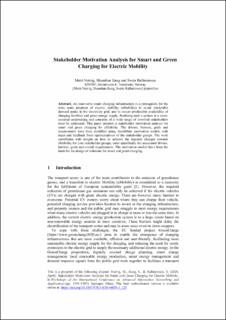| dc.contributor.author | Natvig, Marit Kjøsnes | |
| dc.contributor.author | Jiang, Shanshan | |
| dc.contributor.author | Hallsteinsen, Svein Olav | |
| dc.date.accessioned | 2021-04-23T07:50:22Z | |
| dc.date.available | 2021-04-23T07:50:22Z | |
| dc.date.created | 2020-06-10T12:29:12Z | |
| dc.date.issued | 2020 | |
| dc.identifier.isbn | 978-3-030-44038-1 | |
| dc.identifier.issn | 2194-5357 | |
| dc.identifier.uri | https://hdl.handle.net/11250/2739255 | |
| dc.description.abstract | An innovative smart charging infrastructure is a prerequisite for the wide scale adoption of electric mobility (eMobility) to avoid intolerable demand peaks in the electricity grid, and to ensure predictable availability of charging facilities and green energy supply. Realising such a system is a cross-sectorial undertaking and concerns of a wide range of involved stakeholders must be addressed. This paper presents a stakeholder motivation analysis for smart and green charging for eMobility. The drivers, barriers, goals and requirements have been modelled using ArchiMate motivation models with input and feedback from representatives of the stakeholder groups. The work contributes with insight on how to achieve the required changes towards eMobility for core stakeholder groups, more specifically the associated drivers, barriers, goals and overall requirements. The motivation models have been the basis for the design of solutions for smart and green charging. | en_US |
| dc.language.iso | eng | en_US |
| dc.publisher | Springer | en_US |
| dc.relation.ispartof | Web, Artificial Intelligence and Network Applications | |
| dc.subject | Batterilading | en_US |
| dc.subject | Battery Charging | en_US |
| dc.subject | Smart energy | en_US |
| dc.subject | Smart Energy | en_US |
| dc.subject | Smarte Byer | en_US |
| dc.subject | Smart Cities | en_US |
| dc.subject | HCI and Software Engineering | en_US |
| dc.subject | HCI and Software Engineering | en_US |
| dc.title | Stakeholder Motivation Analysis for Smart and Green Charging for Electric Mobility | en_US |
| dc.type | Journal article | en_US |
| dc.type | Peer reviewed | en_US |
| dc.description.version | acceptedVersion | en_US |
| dc.rights.holder | This is a post-peer-review, pre-copyedit version of an article published in Advances in Intelligent Systems and Computing. The final authenticated version is available online at: http://dx.doi.org/10.1007/978-3-030-44038-1_127 | en_US |
| dc.subject.nsi | VDP::Informasjons- og kommunikasjonssystemer: 321 | en_US |
| dc.subject.nsi | VDP::Information and communication systems: 321 | en_US |
| dc.source.pagenumber | 1394-1407 | en_US |
| dc.source.volume | 1150 | en_US |
| dc.source.journal | Advances in Intelligent Systems and Computing | en_US |
| dc.identifier.doi | 10.1007/978-3-030-44038-1_127 | |
| dc.identifier.cristin | 1814776 | |
| dc.relation.project | EC/H2020/769016 | en_US |
| cristin.ispublished | true | |
| cristin.fulltext | preprint | |
| cristin.fulltext | preprint | |
| cristin.qualitycode | 1 | |
